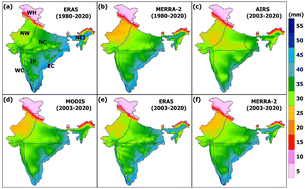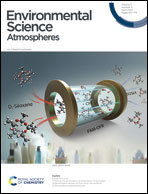Long-term changes in precipitable water vapour over India derived from satellite and reanalysis data for the past four decades (1980–2020)†
Abstract
India has a tropical monsoon climate with significant regional variability in rainfall and temperature, where precipitation is closely connected to precipitable water vapour (PWV). Here, the satellite and reanalysis data are considered to study the spatial and temporal changes of PWV over India in 1980–2020. We have also analysed its potential drivers such as precipitation, surface temperature and evapotranspiration during the same period. The distribution of annual PWV depicts the highest values over the east coast (40–50 mm) and lowest in Western Himalaya (<10 mm). The seasonal distribution shows highest PWV during monsoon (June–July–August–September, about 40–65 mm). Similarly, the monthly cycle of PWV shows the lowest amount in January, which gradually increases with time until it peaks in July, and then decreases thereafter. Inter-annual changes show a peak in 1997–1998, which can be attributed to the strong El Niño event (Nino 3.4 region), during which the increase in temperature leads to more evapotranspiration and thus, enhanced PWV. Among the sources and sinks, evapotranspiration (0.6–0.9), precipitation (0.7–0.9) and surface temperature (0.5–0.6) are highly correlated with PWV across the regions in India. The PWV trends in India are found to be significantly positive (0.6–0.9 mm per year), which can be linked to the recent increase in surface temperature and thus, the increase in atmospheric moisture. This is a concern for regional climate change as PWV is directly connected to water vapour and, thus, to temperature and climate.

- This article is part of the themed collection: Environmental Science: Atmospheres: Highlight India


 Please wait while we load your content...
Please wait while we load your content...